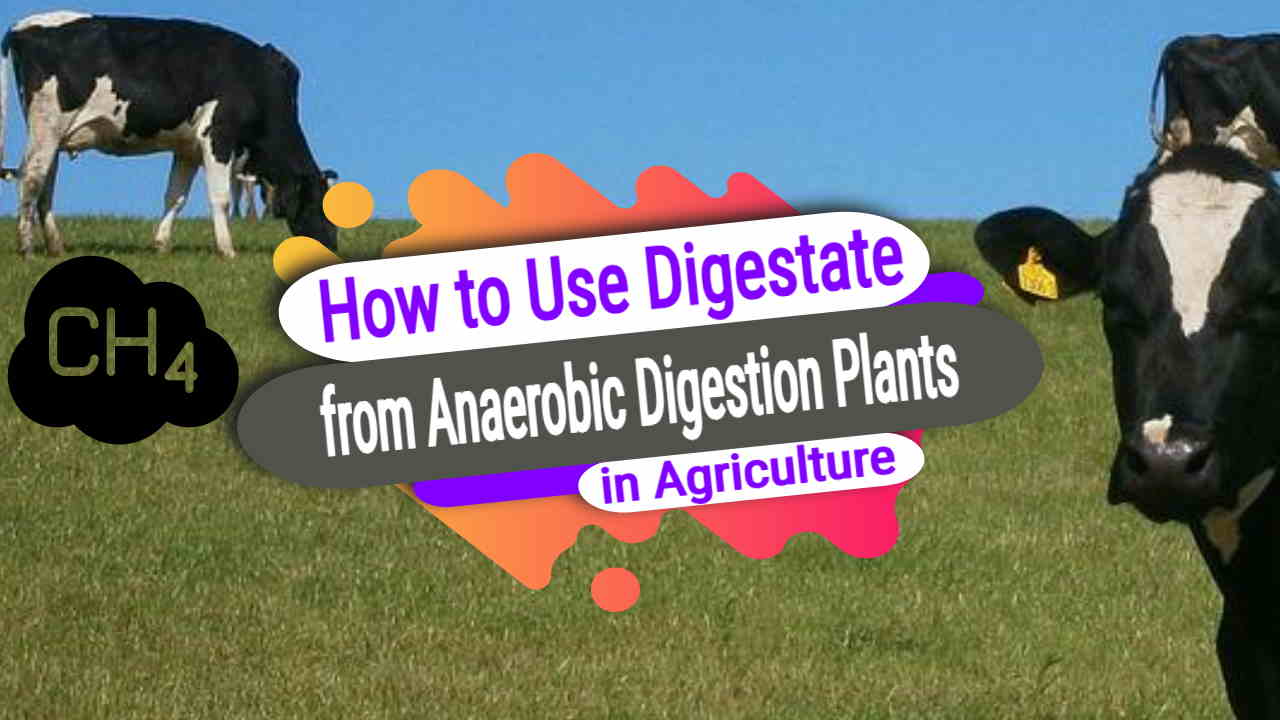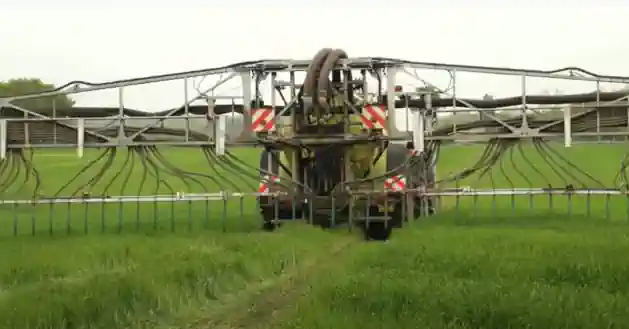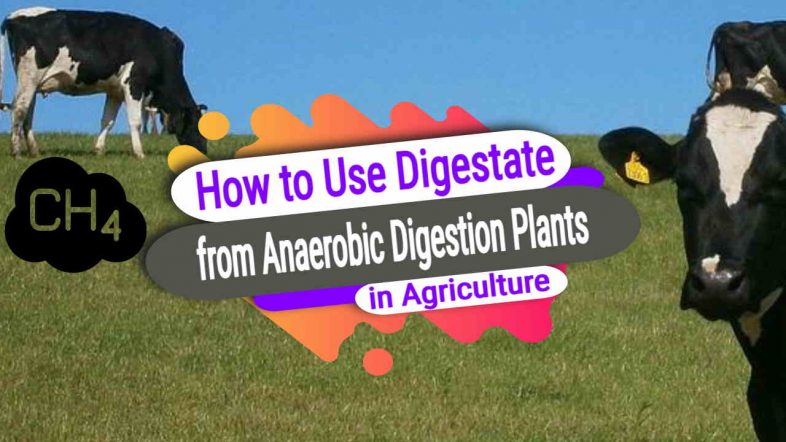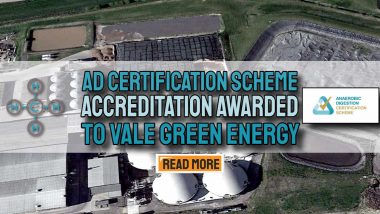It's not plain sailing to use digestate in agriculture, so we thought that we would explain how one farm uses their digestate in their agricultural business in the UK.
Using Digestate from Anaerobic Digestion Plants in Agriculture
Anaerobic digestion is a controlled biological process using biodegradable materials such as food waste and animal manures, to produce renewable energy such as biogas, electricity and heat.
At the same time, a byproduct is a valuable output, namely the processed liquid and solid slurry, or “digestate” that can be used by farmers. However, to avoid UK waste permit requirements only some types of food waste can be used.
However, there are over six hundred anaerobic digesters operational in the UK (2022), with many more in planning or being built, so the beneficial use of digestate is becoming increasingly important.
Undigested biomass (also known as digestate solids, fibre, or biofiber) found in anaerobic digester effluent (digestate) can be used to make value-added byproducts. Organic fertiliser, livestock bedding, compost, fuel pellets, and construction materials (medium density fiberboard and fibre/plastic composite materials) are just a few examples of value-added byproducts made from digestate solids.
Anaerobic Digestion Tanks
You can see some of the digestion tanks and gas engines in the video here. Food waste comes in through the reception building. It is processed there to make a slurry with a suitable solids content, blended for Nitrogen and Carbon Content (C: N ratio), and then enters the digestion tanks, where bacteria start to break down the food waste in the absence of oxygen.
The result is that the organisms give off methane and a mix of other gases which are captured in a domed roof. That raw biogas is cleaned up and fed through the gas engines also shown. They burn the gas in a standard internal combustion engine conversing it into electricity, which in turn is fed into the National Grid.
The plant in the YouTube-linked video above produces enough electricity to feed around 4,000 houses as well as to provide electricity to power its own systems.

The Liquid Fertilizer Called Digestate
Biogas plant operators are left with a whole liquid fertilizer called digestate, which they spread back to farmland as a nutritious product to grow crops.
Any AD unit treating animal byproducts such as cooked and uncooked meat or catering waste must use a pasteurization step in the AD process to ensure that the digestate is safe from transmitting disease vectors.
Testing has shown that after pasteurization pathogen levels in digestate are a fraction of the levels in other organic materials used in farming such as manures and slurries. The Biofertilizer Certification Scheme is an independent Quality Assurance scheme.
Most investigations have shown that the vegetable nitrate content decreased significantly when applying digestates as an alternative to mineral fertilizers.
Digestate can be directly land applied and incorporated into soils to improve soil characteristics and facilitate plant growth. When properly processed, dewatered digestate can be used as livestock bedding or to produce products like flower pots.
Digestate can also be further processed into products that are bagged and sold in stores. Some emerging technologies can be employed post-digestion to recover the nitrogen and phosphorus in digestate and create concentrated nutrient products, such as struvite (magnesium-ammonium-phosphate)
Purpose of the Biofertilizer Certification Scheme
The Biofertilizer Certification Scheme (BCS) (UK) has been developed to ensure that digestate from anaerobic digestion is safe for the health of animals and plants as well as consumers. Digestate certified for end-of-waste and quality assurance status is referred to as biofertilizer and is not classed as waste and is actively sold as a natural biofertiliser.
The UK AD industry trade association ADBA also administers a similar scheme alongside good digester operating practice training. By earning the ADCS Certification, companies like Malaby Biogas have established themselves as leaders in the implementation of standards for AD plant operation that are widely recognised by the AD industry.
By presenting best practice training, ADBA members have a plan to bring their industry's standards applied by even the newest plant operators up to the level of the most modern and best-trained operators. A saving grace for all the work needed to train staff in best practices lies in the fact that experts in the industry believe that participating in this programme will quickly pay for itself. It will do that, and more, through the savings in insurance premiums and the avoidance of costly operational mistakes.
UK Waste Permit Exemption for “No Waste” Agricultural Biogas Facilities
Here is further reassurance to digestate users, who may be concerned about accepting this digestate. The digestate certified under the scheme is considered by the authorities to be a product, not a waste, which means there is no need to apply for:
- an environmental permit deployment or
- a waste exemption to become certified digestate producers.
But, for certification, they must pass strict quality controls. The most important of those currently is BSI PAS 110.

BSI PAS 110
As set out in a specification published by the British Standards Institute known as BSI PAS 110, the nutrient value of digestate will depend on the materials used to feed the digester. Framers will achieve better crop performance by using a good quality digestate.
While digestate may offer excellent fertilizer potential due to its higher proportion of mineralized nutrients compared to undigested materials, attention must be paid to avoid over-applying digestate to land, which can cause negative effects.
Is It Right for My Farm to Buy BSI PAS 110 Fertiliser?
It can be right to buy BSI PAS 110 Fertiliser for any farm as long as its use is not excessive and it can be applied at the right time seasonally in accordance with good fertiliser planning.
Ask your proposed supplier for an analysis of the batch to be supplied or get the digestate analyzed yourself and use this information in your fertilizer planning.
Typically, the whole digestate has five kilograms per tonne of total, nitrogen, of which 80% or four kilograms per tonne Is present as a readily available nitrogen source.
Utilizing digestate solids for bedding provides a significant cost offset to dairy and livestock farms. In addition, excess solids may be sold to neighbouring farms for bedding or soil amendment, creating a revenue stream and route for nutrient export.
A Fertiliser More Potent Than Cattle Slurry
This is a more potent fertiliser than cattle slurry, which has only 45% readily available. When sold digestate also typically contains 0.5 kilos per tonne of phosphate, which is 50% available and 2 kilos of potash, which is 80% available. We do the digestate is it's a complete nutrient feed for the crop in one material!
You can't actually source this type of product from manufactured means. That's because it comes from the organic waste.
“Digestate is a complete mix of nutrients.”
It contains a complete mix of nutrients, which the plants in the crop pick up very readily.
The crop will change colour (become a deeper green colour) within probably about seven days of application and grow away very rapidly.
Land Spreading of Digestate
It is possible to run digestate spreading equipment which achieves a 32-metre wide precision spreading zone with great accuracy. Material is applied through the machine as shown in the above-linked video. The main benefit of spreading in digestate is to reduce the number of applications of fertiliser.
We can apply a dressing on week 1, which is the first dressing this week (see video) and then it will have a prune fertiliser later. Using a good PAS 110 certified fertiliser can take one dressing away completely, band it's a complete feed for the crop.
We could, in fact, apply digestate through each crop. However, this AD plant operator is in at the moment right up to the flag, beyond which we have to suspend the use of this fertiliser.
Digestate Land Application
If we required so, the boom can actually apply the digestate straight to the ground.
In the video, you can witness digestate irrigation (recycling) in progress. You will see that the little pipes on the double bar actually drop through the crop. That means that you don't get any damage to the crop. They're flexible enough, so they actually drop the digestate on the floor.
It's actually immediately on the soil, so the nutrient can be taken up by the root very quickly with very little of the valuable ammonia (and through that nitrogen) being lost as air pollution because you're actually applying it straight onto the ground.
Organic molecules stimulate soil microbial activity, which in turn reduces the amount of inorganic N 39, 41 that may be absorbed. Compounds that require oxic conditions for decomposition, such as those found in the soil, may decompose as a result of basic environmental changes (anoxic conditions in digestate storage, oxic or semi-oxic soil conditions).
Reduced Loss of Nitrogen Content
You're not going to see the nitrogen losses attributable to alternative fertilisers such as farm manure. That nitrogen from alternative fertiliser usage also passes through the atmosphere, but due to the renewable source, it's an environmentally wise choice. It's an awful lot better to apply fertiliser straight to the ground like this.
You're not losing nutrients using digestate on-farm in much the same as using livestock, manure or slurry can take farm businesses through using the digestate with a fact, qualified advisor and balanced fertilizer use within the farm.
Depending on the feedstock composition, anywhere from 20% to 95% of the organic matter is destroyed in AD. The digestate (biogas effluents) that is left over after AD is processed is commonly utilised as fertiliser. Approximately 20% of all animal waste and biomass collected in Germany between 2011 and 2025 will be utilised as a fuel in biogas plants, according to government estimates.
Organic molecules stimulate soil microbial activity, which in turn reduces the amount of inorganic N 39, 41 that may be absorbed. Compounds that require oxic conditions for decomposition, such as those found in the soil, may decompose as a result of basic environmental changes (anoxic conditions in digestate storage, oxic or semi-oxic soil conditions).
Nutrient Management Planning
Set up a nutrient managing campaign and a nutrient management plan. Excess use of digestate must be avoided.
The nutrient management plan, the latest version of which for Manor NPK, is free for others to use, and will help farmers to calculate how much of the nutrients in digestate will be available to the crop. Just enter the details of the field, in which you will apply it to the soil, type and location.
You will need to estimate the rainfall and then enter an application with your dosing rates, method and timing of application. Manor NPK will give a summary report of crop available nutrients for the current crop and will give an estimate of the financial savings on fertilizer, which can be made.
It is often said that there is a certain limit to the quantity of nutrition that may be obtained from digested products since the raw materials used to make them affect their quality and safety. While that is true for digesters which process Municipal Organic Waste (MOW) such as the Organic Fraction of Municipal Solid Waste (OFMSW) in which there are generally heavy metals which severely limit the number of applications of digestate as fertiliser in order to avoid unhealthy bid-up of those metals in the land this does not apply to the same extent in agricultural digestion.
What are the Applications for the Digestate from Anaerobic Digestion?
A digestion process that takes place by the action of anaerobes in a nutrient-dense state is able to be used as a renewable fertilizer in vegetable production. Complex organic nitrogen compounds in digested food products can also be mineralised in digesting equipment. A portion of a digesting microorganism uses the nitrogen in a digester for growth.
Digestate is rich in nutrients and can be used as fertilizer for crops. Biogas is produced throughout the anaerobic digestion process.
Digestate Seasonality
Digestates produce all year round, so must be kept for field use. The effectiveness attributed to N applied to manure is much greater in spring than in autumn.
Approximately 50% of the N output is available for use during the spring application versus about 20% and 25% respectively for application during the summer and fall. For the high N use effectiveness and to decrease N emissions, it is desirable to use digestate in late summer applications.
What are the Applications for Digestate from Anaerobic Digestion?
A digestion process that takes place at anaerobes in a nutrient-dense state is able to be used in regenerating and using fertilizers in vegetable production.
Complex organic nitrogen compounds in digested food products can be mineralised in digesting equipment. A portion of a digesting microorganism uses nitrogen in a digester for growth.
Conclusion
Digestate is the material that is left over following the anaerobic digestion process. Its primary use is as a natural fertiliser which is both low polluting, sustainable and does not add to climate-changing carbon emissions.
When properly processed, dewatered digestate can be used as livestock bedding or to produce products like flower pots. The liquid portion of digestate can be directly land applied and incorporated into soils.
Digestate can also be made into a soil amendment to improve soil structure and its ability to retain water.
A digestate may be certified as BS PAS 110 Compliant Compost when made from crop remnants from food production, and when special energy crops comprise the feedstock for the anaerobic digestion of farm waste in agricultural applications. But municipal waste products do not comply.
The result can be the successful agricultural output of digestate and raised crop production due to the fertilising effect of PAS 110 compliant digestate land spreading.





